nForce 500: nForce4 on Steroids?
by Gary Key & Wesley Fink on May 24, 2006 8:00 AM EST- Posted in
- CPUs
Synthetic Graphics Performance
The 3DMark series of benchmarks developed and provided by Futuremark are among the most widely used tools for benchmark reporting and comparisons. Although the benchmarks are very useful for providing apples-to-apples comparisons across a broad array of GPU and CPU configurations, they are not a substitute for actual application and gaming benchmarks. In this sense we consider the 3DMark benchmarks to be purely synthetic in nature but still valuable for providing consistent measurements of performance.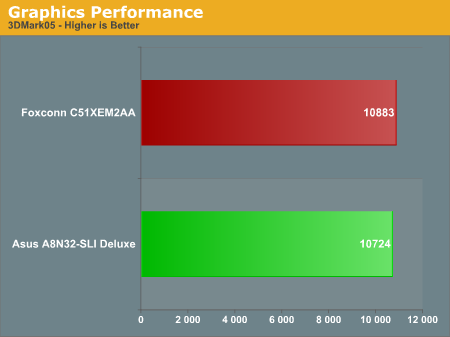
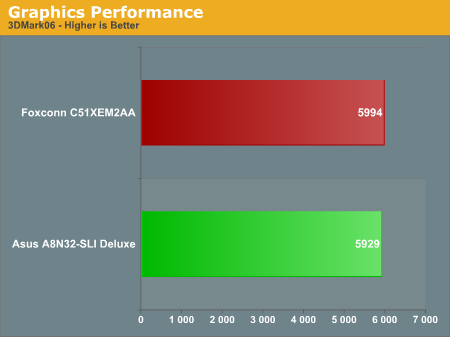
Our nForce 590 SLI system improves upon the performance of the nForce4 system by an average of 1%. These test results are basically a tie and indicates both platforms are performing equally with the same video card.
General System Performance
The PCMark05 benchmark developed and provided by Futuremark was designed for determining overall system performance for the typical home computing user. This tool provides both system and component level benchmarking results utilizing subsets of real world applications or programs. This benchmark is useful for providing comparative results across a broad array of Graphics subsystems, CPU, Hard Disk, and Memory configurations along with multithreading results. In this sense we consider the PCMark benchmark to be both synthetic and real world in nature while providing consistency in our benchmark results.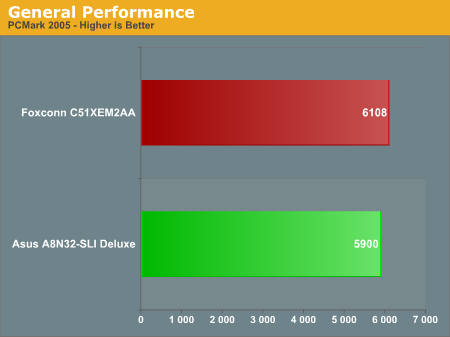
The margins are little wider at 4% in the PCMark05 results, but the margin of error in PCMark05 is also slightly larger. It is obvious from our test results so far that either platform provides excellent results. If you have a socket 939 platform and are happy with its feature set then we do not see a reason to upgrade at this time.
Rendering Performance
We have added the Cinebench 9.5 and POV-RAY 3.6 benchmarks as they heavily stress the CPU subsystem while performing graphics modeling and rendering. We utilize the standard benchmark demos in each program along with the default settings. Cinebench 9.5 features two different benchmarks with one test utilizing a single core and the second test showcasing the power of multiple cores in rendering the benchmark image.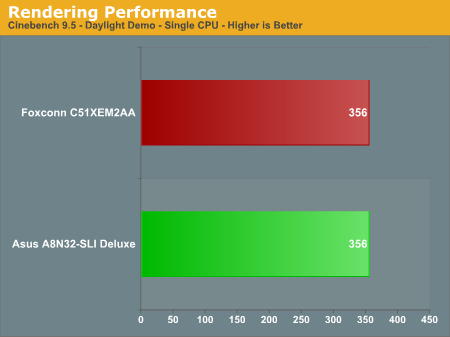
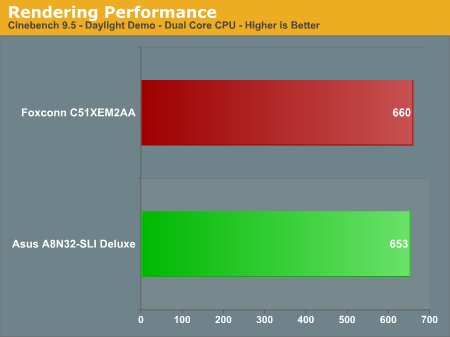
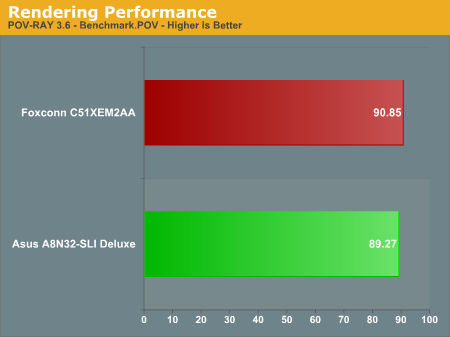
The nForce 500 desktop platform shows small and almost imperceptible differences in these benchmarks, with the 590 AM2 performing slightly better in the demanding POV-RAY benchmark. Once again both platforms are performing equally.










64 Comments
View All Comments
Olaf van der Spek - Wednesday, May 24, 2006 - link
<quote>These devices can be configured in RAID 0, 1, 0+1, and 5 arrays. There is no support for RAID 10.</quote>That's probably because there's effectively no difference between 1+0 and 0+1 on a good controller.
Olaf van der Spek - Wednesday, May 24, 2006 - link
Doesn't this require support from the modem/router too?
The delay (usually) happens in the modem and not in the network card.
Zoomer - Saturday, May 27, 2006 - link
No, because you make the bottleneck your network card, instead of the modem. :)There will be a slight loss of throughput. Read some QoS articles. lartc.org is also a good resource. I bet it's the same principle. ;)
Trisped - Wednesday, May 24, 2006 - link
<quote>Multiple computers can to be connected simultaneously </quote>http://www.anandtech.com/cpuchipsets/showdoc.aspx?...">http://www.anandtech.com/cpuchipsets/showdoc.aspx?...
take out the "to"
Gary Key - Wednesday, May 24, 2006 - link
Thanks, it is corrected.....Googer - Wednesday, May 24, 2006 - link
When benchmarking core logic it's should be a high priority to measure I/O performance, since that is the primary job of any AMD Chipset.Where are the HDD, Network, Audio, and R.A.I.D. benchmarks?
Gary Key - Wednesday, May 24, 2006 - link
I answered above but we will have full benchmarks in the actual motherboard articles. Our efforts in the first three days was to prove out the platform and features that were added or changed (still doing it, feels weird to be up almost 72 hours). In answer to your question-
Foxconn Board
Network-
Throughput - 942 Gb/s
CPU utilization - 14.37% (with TCP/IP offload engine on), near 30% off.
HDD/RAID
No real difference compared to nF4 as we stated. The numbers are within 1% of each other. The interesting numbers will be in our ATI SB600 comparison.
Audio-
Dependent on the codec utilized in each motherboard, the RealTek ALC883 used in most of them have the same numbers as the nF4 boards. The only difference is the new 1.37 driver set we used. It will be interesting in the comparison as Asus went back to ADI for HDA.
Pirks - Wednesday, May 24, 2006 - link
That's why AT is my favorite review site - 'cause you're really crazy bunch :-) Just don't ruin yourself completely, we need you!Gary Key - Wednesday, May 24, 2006 - link
The ending should read NF4 Intel or ATI/Uli AMD boards. Where is that edit function? Hit enter too soon. :)Gary Key - Wednesday, May 24, 2006 - link
They will be in our roundup comparison and ATI AM2 articles.